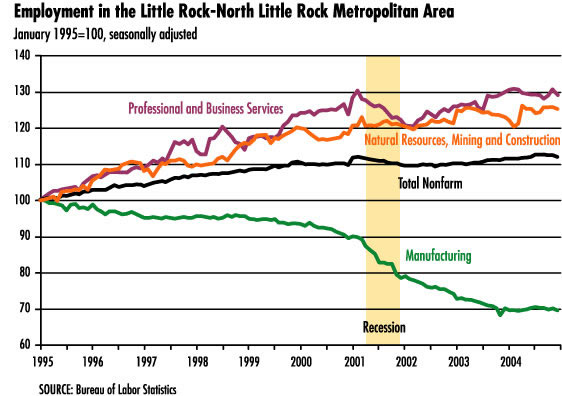District Overview: Service Industries Keep Employment Steady in Arkansas' Capital
The national recession of 2001 took a toll on employment in the Little Rock area, as it did in most other parts of the country. But the dent in jobs in Arkansas' capital was relatively short-lived. Credit the service industry for that.
From early 1995 to March 2001 (the official starting point of the recession), total nonfarm employment in the Little Rock-North Little Rock metro area (Little Rock) steadily rose for a total increase of 11.8 percent.1 From March 2001 through December 2004, long after the recession officially ended, employment in Little Rock had increased by 0.2 percent.
As shown in the figure, the most prominent feature of the employment pattern for Little Rock has been the full recovery from the employment losses during the recession. For example, from the beginning to the nadir of the recession, employment in Little Rock dropped 2.2 percent. Other metropolitan areas in the Eighth District fared similarly: In Memphis, employment dropped 1.5 percent, and in St. Louis, 2.5 percent. However, Little Rock bounced back more than Memphis and St. Louis. From the lowest level of employment to the end of 2004, Memphis' employment grew 1.4 percent and St. Louis' grew 1.0 percent, while Little Rock's rose 2.5 percent.
The fact that employment in Little Rock has recovered well from the recession is noteworthy in large part because of the concurrent and persistent decline in manufacturing. Over the past 10 years, manufacturing employment has declined more than 30 percent; the majority (64 percent of the total change) of the losses occurring from the beginning of 2000 through the end of 2003. Other goods-producing sectors were also declining or stagnant even before the recession. (Somewhat encouragingly, manufacturing employment stabilized during 2004, although it still accounts for only 7.7 percent of total nonfarm employment, compared with 10.8 percent for the United States as a whole.)
What offset the loss in manufacturing? Service industries. They account for almost 86.9 percent of total nonfarm employment. But not all service industries have fared equally well during the expansion, the recession or the recovery. In particular, employment in the information sector, which includes publishing, broadcasting and telecommunications firms, helped lead the expansion and the recovery from the recession but declined during the last half of 2004. Another leader among service industries is the category of professional and business services, which includes legal, accounting, design, computer, scientific and technical, as well as advertising services. Its employment rose 2.3 percent from January 2002 through December 2004.
A goods-producing sector that has experienced substantial growth over the past 10 years is the natural resources, mining and construction (NMC) sector. From 1995 through March 2001, this sector's employment grew faster than total nonfarm employment (23 percent vs. 11.8 percent). NMC employment continued to outperform total nonfarm employment during and after the recession. For example, NMC employment grew by 1.8 percent from March of 2001 through December of 2004, while total nonfarm employment grew by only 0.2 percent. Much of this growth in employment may be attributed to construction of residential and commercial property, which was spurred by the historically low cost of borrowing as the federal funds target rate was dropped by more than four percentage points. In fact, according to the Freddie Mac Mortgage Market Survey, interest rates on 30-year fixed-rate mortgages dropped from more than 8 percent to less than 6 percent between the beginning of 2000 and the end of 2002. From that point forward, mortgage interest rates remained near or below 6 percent.
In summary, the labor market in Little Rock has proved to be resilient to the national recession in 2001. This resilience can be attributed in part to the lack of reliance on manufacturing for employment. In fact, despite the dominance of the service sector, the recession led to even more rapid restructuring away from manufacturing and into service industries. In addition, the construction industry helped Little Rock weather the ill effects of the 2001 recession, likely due in large part to low mortgage interest rates.
Endnotes
- The Little Rock-North Little Rock metropolitan area includes Faulkner, Grant, Lonoke, Perry, Pulaski and Saline counties, all in the state of Arkansas. [back to text]
Views expressed in Regional Economist are not necessarily those of the St. Louis Fed or Federal Reserve System.
For the latest insights from our economists and other St. Louis Fed experts, visit On the Economy and subscribe.
Email Us


